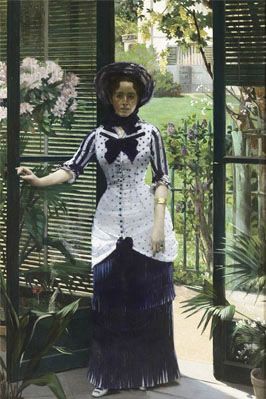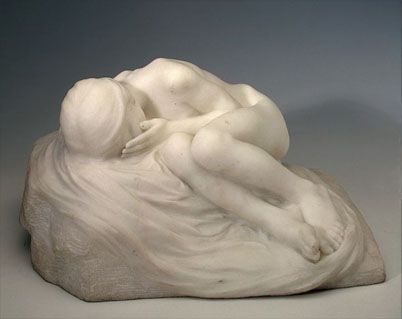 |
Right: In the Greenhouse, 1881
 |
I saw the above dress (on the left) at the New York Post fashion section. This is the description for the dress:
In a pairing that will never go out of style, the Musée d’Orsay is displaying impressionist paintings alongside dresses and accessories of the late 1800s in its "Impressionism and Fashion" exhibition, created in collaboration with the Metropolitan Museum of Art in New York and the Art Institute of Chicago. The show — featuring rarely seen masterpieces from Manet, Monet, Renoir and Degas beside the evolving fashions of their day — will migrate to the Met this February.The dress combines stripes and polka dots in an ingenious way. The polka dots are mimicked in the long line of buttons. Bows repeated at various points on the dress add visual interest. The ruffles at the bottom half of the dress are repeated on the sleeves. The dress combines these differing elements to make a cohesive whole. The gown is attractive and feminine, with the clinched waist that accentuates the shapely figure of any woman.
Imagine such a dress being designed, let alone worn, in our era.
There was nothing more on the dress, so I went to the Metropolitan Museum of Art site and searched for Albert Bartholomé, and this is what I found on him:
Bartholomé is best known as the academic sculptor who prepared Degas's wax sculptures for casting into bronze. However, he did not take up sculpture until after the death in 1887 of his wife, Périe, who is the subject of this portrait [The Artist's Wife Reading - see below]. Between 1879 and 1884 he exhibited pastels in the Paris salons. Today these works are exceedingly rare; indeed no other surviving pastel is known.
 |
In the Greenhouse
Circa 1881
Oil on canvas
H. 233cm, W. 142 cm
Below, from the Hermitage Museum in St Petersburg, Russia:
 |
Mid-1890s
Marble.
H. 26 cm
Below, at the Musée D'Orsay in Paris:
 |
1906
Plaquette uniface en cuivre argenté
H. 0.217 ; L. 0.17
Below, from the Metropolitan Museum of Art in New York:
 |
1883
Pastel and charcoal
H. 50.5, W. 61.3 cm